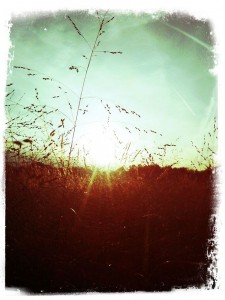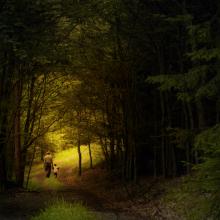garden
“DO YOU MAKE any money from it?” a visitor asked as we walked behind my house, where goats, chickens, fruits, and vegetables grow among the weeds. I shook my head and laughed.
We entered the garden where my 74-year-old father knelt, breaking up soil with an old cultivating fork. He was planting spindly tomato plants I had started from seed and almost abandoned.
We don’t make money from it, but the garden is the place where my father cultivates joy. When I was a child, he poured water on rows of collards to wash away stressful days working for a Washington, D.C., nonprofit. Gardening restores his soul. These days, Dad splits his time between my parents’ home in Ohio and my home in rural Georgia, planting gardens in both places.
We don’t weigh the bushels of okra, cantaloupe, peppers, watermelon, and beans to see if they equal or surpass expenditures of time or money spent on Dad’s trips down South. Some work can’t be measured in dollars.
How the “welfare state” is designed to subsidize affluence rather than fight poverty.
When I decapitated the sunflowers today, the birds had already
pecked them mostly bald. I sawed through those thick necks with
silver shears, squash leaning to cup falling petals and black seeds in her
green palms. I was cutthroat, ripping this food from the garden. I knew
how fierce and warlike the small wrens had become, and, sure enough,
there were the fearless nails in my scalp, clawing for my soul.
A short walk from the Temple Mount, in the East Jerusalem neighborhood of Al Bustan, there’s a plan to replace dozens of Palestinian homes with a new tourist destination: a lush garden on the site where some say King Solomon built his royal gardens and wrote the book of Ecclesiastes.
Bio: Rev. Heber Brown III is pastor of Pleasant Hope Baptist Church in Baltimore. Brown, Aleya Fraser, and Darriel Harris started the Black Church Food Security Network to connect black churches in food deserts with black farmers and urban growers.
Website: blackchurchfoodsecurity.net
1. How did the Black Church Food Security Network get started? As a result of the uprising [following the death of Freddie Gray], many corner stores in the most impoverished neighborhoods in Baltimore were put out of commission. It was an unjust arrangement to have entire neighborhoods dependent on corner stores for their food before the uprising, but the uprising intensified that already strained and unjust social arrangement.
Aleya [Fraser] started to call her farmer friends and food distributors—African-American grocers in Philadelphia and D.C.—and they started moving food to Baltimore. We transformed my church into a food depot and distribution center. We would process food donations from all over, and then we would pile the food in our church bus and I would drive the food around to those communities that needed food. We would set up shop on the corner and give out the food. We did that for nearly three weeks, and we realized that we had the beginnings of an alternative food system. The name came later; the action came first.
When God coupled the earth with the breath of eternity, our souls and the soil were fused and our destinies perpetually intertwined. While many of us have been taught that human beings have dominion over the Earth, we have not understood that what we do to Mother Earth, we do to one another and to God.
Dominion theology has led to domination, abuse, and destruction of Mother Earth and human communities. Every time we strip the land of its diversity, we strip a layer of humanity from our collective souls. Soil is also a community of diverse beings — some visible to the naked eye, some microscopic. A diversity of beings distinguish fertile soil from lifeless dirt. When industrial agriculture or chemical spills make these beings homeless, our soil becomes dust and is gone with the wind. Regardless of their visibility to the human eye, maintaining the homes of microbes intact, is what keeps the land fertile for growing crops which feed human beings. Adding microbes to “the least of these” who deserve our protection is truly an act of self preservation.
Respect and protection is a recurring casualty of dominion theology in that dominated land requires dominated people to work it. Plantations required slaves, and agribusiness requires exploited immigrants. Generational shame was whipped into the minds of enslaved Africans as their backs were abused in cultivating the land. Over the course of 400 years, a healthy relationship with Mother Earth was one of those legacies lost, stolen, or strayed for many African Americans. Restoring a healthy relationship with the land is a vital prerequisite for our urban youth to turn their food deserts into an oasis of food sovereignty.
From white villages Easter bells resound.
Rejoice! Give thanks! I raise my voice
Evil disappears from the world.
And that means somewhere God must be.
Yes, his blood was on us once,
making us famous blades within the blades
community. I mean, many of us
had taken blood and sweat before
from lions and dogs and even fallen birds
or lovers and killers and the killed
but this was the first time we took both
at the same time, from the same creature.
You humans have that saying,
Blood, sweat, and tears. By this you signify work.
Consider the lilies of the field, he said
of our cousins. They neither work nor spin
but I tell you that not even Solomon
in all his glory was clothed like them.
When you hear about stewardship in church, you probably think of your checkbook. Stewardship is the term we use to talk about financially supporting our churches and organizations. But another holy use of the word involves being stewards of creation.
When I hear the word stewardship, I feel the crunch of snow and branches under my feet. I see the trees and paths of the woods owned by my parents’ best friends, where I spent much of my childhood hiking, hunting, skiing, picking apples, and feeding chickadees out of the palm of my hand. It’s one of the places where I gradually heard my calling to work for the care of creation. And the word stewardship transports me to a specific day in my childhood, walking in the woods with my dad’s best friend, Leo, when he pointed to a tree and said he would have to take it down.
How could he kill a tree? I hassled him; I got indignant. I said that nature should be left alone to do her thing. But Leo explained that I was wrong — he managed the land. It wouldn’t be just fine on its own; rather, it needed his careful eye to manage the trails, cut down sick trees, and hunt deer.
I MET MARKKU and Leah Kostamo of A Rocha, an international Christian environmental organization, on the set of a television show in Toronto. The show was Context, hosted by the welcoming Lorna Dueck. This show explores the stories behind the news from a frankly Christian viewpoint.
I had been invited to talk with Dueck about my MaddAddam future-time book trilogy, and in particular about characters in the second book, The Year of the Flood, called the “God’s Gardeners,” a green religious group that raises vegetables and bees on flat rooftops in slums. It is headed by a man called Adam One and includes a number of ex-scientists and ex-doctors who have withdrawn from a too powerful, greedy corporate world in which they can no longer function ethically. The God’s Gardeners group represents the position—probably true—that if the physical world is going to remain possible for human life, religious movements of many kinds will be an important element. We don’t save what we don’t love, and we don’t make sacrifices unless “called” in some way to make them by what AA refers to as “a higher authority.”
Dueck and I talked a little about that, and then—surprise—right before me were two people who closely resembled the God’s Gardeners of my fiction. Leah and Markku Kostamo are walking the God’s Gardeners walk—through A Rocha, a hands-on creation-care organization. A Rocha’s origins go back to the Christian Bird Observatory (cf. St. Francis) founded on the coast of Portugal by Peter and Miranda Harris in 1983. Leah met the Harrises in 1996 when she took a class they were teaching at Regent College in Vancouver, British Columbia, and A Rocha Canada was born. It was soon augmented by Markku, an environmental scientist. A Rocha is now running 20 projects around the globe, engaged in everything from habitat restoration to organic community farming.
The wheelbarrow outside the sanctuary was overflowing with vegetable scraps; decomposing matter filled the baptismal font; and a pile of rich brown soil replaced the Communion table.
Ashley Goff, minister for spiritual formation at Church of the Pilgrims, wanted to convey a message about the cycle of nature this fall, and she could think of no better analogy than the congregation’s growing enchantment with compost.
“I wanted them to see the process of life and death and change,” she said of her Presbyterian Church (USA) congregation of 70. “It’s a dying and a rising, where new life begins.”
Across the country in the past decade, hundreds of houses of worship have started composting, relating it to theological concepts of resurrection and stewardship.
UNTIL RECENTLY, a company in New York City offered “a ride through a real New York City ‘ghetto’”—a $45 bus tour of the Bronx, reportedly patronized mainly by European and Australian tourists. One news report described the tour guide sharing lurid stories of crime and arson from the ’70s and ’80s, making insensitive comments about everything from local architectural landmarks to people waiting in line at a food pantry, and warning about the “pickpockets” in wait in a certain park. After an outcry from residents and officials, angry that the place they call home would be reduced to out-of-touch stereotypes, the tour company shut down in May.
That someone would even think of fleecing misguided tourists this way hints at the complicated, sometimes contradictory, role that cities play in our culture: In our collective imagination they represent both civilization’s pinnacle (arts, style, technology, intellectualism, innovation, industry, finance) and depravity’s depths (crime, corruption, exploitation, decadence, filth). For much of the 20th century, many people of means fled cities for the pastoral promise of the suburbs, while many a farm girl or boy dreamed of escaping to a city and tasting the bustle and thrill: “Until I saw your city lights, honey I was blind.”
And yet cities are not only symbols, but real and intricate places. Whether booming or busting, they shape and are shaped by the people in them. Both the built structures and the people of a city have stories to tell. But a fleeting tour-bus view with distorted narration can lead us down an alley with no exit.
Here are some different takes on the bright lights of the big city.
Early morning
before he unlocks the church gate
the rector kneels before
the gridiron fence surrounding the Cathedral,
not in prayer
but to collect empty wine bottles,
snack bags, and used condoms.
After shoving them into a bag
he turns the latch key and enters the churchyard
shutting it behind him.
The hollow, thunderous deadbolt
echoes through trees like the voices of
ancient saints.

Autumn mornings -- when the cool rain is hitting the tin roof and the breezes blow with enough swagger to make the trees bow in admiration -- remind me of when my second daughter was born and after we had held her in our arms for some time we knew exactly what her name would be. Jorah (meaning "autumn rain" in Hebrew.)
I cannot help but reminisce about those summer sunsets (pictured above) when the sweaty warmth stretched late into the day. Those days were full of bold, luminous life. A bountiful garden. Happy hens sauntering. Silly children splashing and running and laughing.
During the summer season, my wife's delicate hands turned, with soil under her nails and calluses here and there from hours of loving toil in the garden -- always walking towards me with a bowl full of color and a mouth cracked open by a proud grin. She mothers the vegetables in her with almost as much attentiveness and love as her own babes.
Now autumn's crisp air awakens us as we feel the seasons shifting. The trees cast all their energy into turning shades of green into glorious reds, yellows, oranges and golds, a celebratory finale before bowing out for a season of slumber.
Ms. Maathai's life and work are examples of the truth of the adage, "Nothing is more powerful than a made up mind." She made up her mind that planting trees is a way to make life better for rural women and for all of humankind. She wanted to plant one tree for every person in Kenya. An the Green Belt Movement has planted tens of millions of trees.
This Sunday (Oct. 9) , Sesame Street will introduce a brand-new Muppet character — a magenta-faced, impoverished 7-year-old named Lily who represents one of the 17-million Americans who struggle daily with hunger and poverty — during a rare prime-time special called, "Growing Hope Against Hunger."
Each moment is pregnant with new possibilities waiting to be born, alive with new beginnings, God's secrets not yet heard, God's dreams not yet fulfilled. These were the thoughts that lodged in my mind as I meditated on Isaiah 48:6-8 this morning. So many good Christian people I talk to are afraid that their prayer life will become stale, their spiritual disciplines empty rituals. Some make this an excuse for their lack of discipline in prayer. And prayer does become stale and meaningless if we don't know how to stir our imaginations and awaken our creativity to new thoughts, new patterns and new possibilities for prayer.
Tools for prayer are creative opportunities not formulae for success
One of my greatest fears as I continue to share these tools for prayers is that some of my readers will see them as another formula that will make them more successful and more prayerful. Of course that is possible, but what I hope is that we will all see these as tools as ways to stir our imaginations and open our minds to new ways to express the prayers God has placed in our hearts, stimuli that awaken our creativity to the brand new possibilities of ways that God can speak to us, in us, and through us.
 With the scandal around Rupert Murdoch growing by the day, a full-fledged boycott of News Corp. has been launched on the internet, according to the Washington Post.
With the scandal around Rupert Murdoch growing by the day, a full-fledged boycott of News Corp. has been launched on the internet, according to the Washington Post.
The website Boycott Murdoch also has Facebook and Twitter pages. While the boycott has received coverage on many mainstream news outlets, it has yet to gain much traction. The Facebook page has less than 700 fans and the Twitter page is approaching only 1,000 followers. To make even a small dent in Murdoch's bottom line, the boycott will need to metastasize, and quickly.
My favorite characters in The Lord of the Rings are the Ents -- an ancient race of giant living, talking, breathing trees in J.R.R. Tolkien's fictional land, Middle Earth. I have a little confession to make: Whenever I hear a reading from Isaiah 55 where it says, "The mountains and hills before you shall burst into song and all the trees of the field shall clap their hands," I always picture the Giant Ents from The Lord of the Rings. And then I picture these clapping trees from Isaiah holding little Hobbits in their branch arms in what ends up a willful conflation of Middle Earth and Major Prophet.












